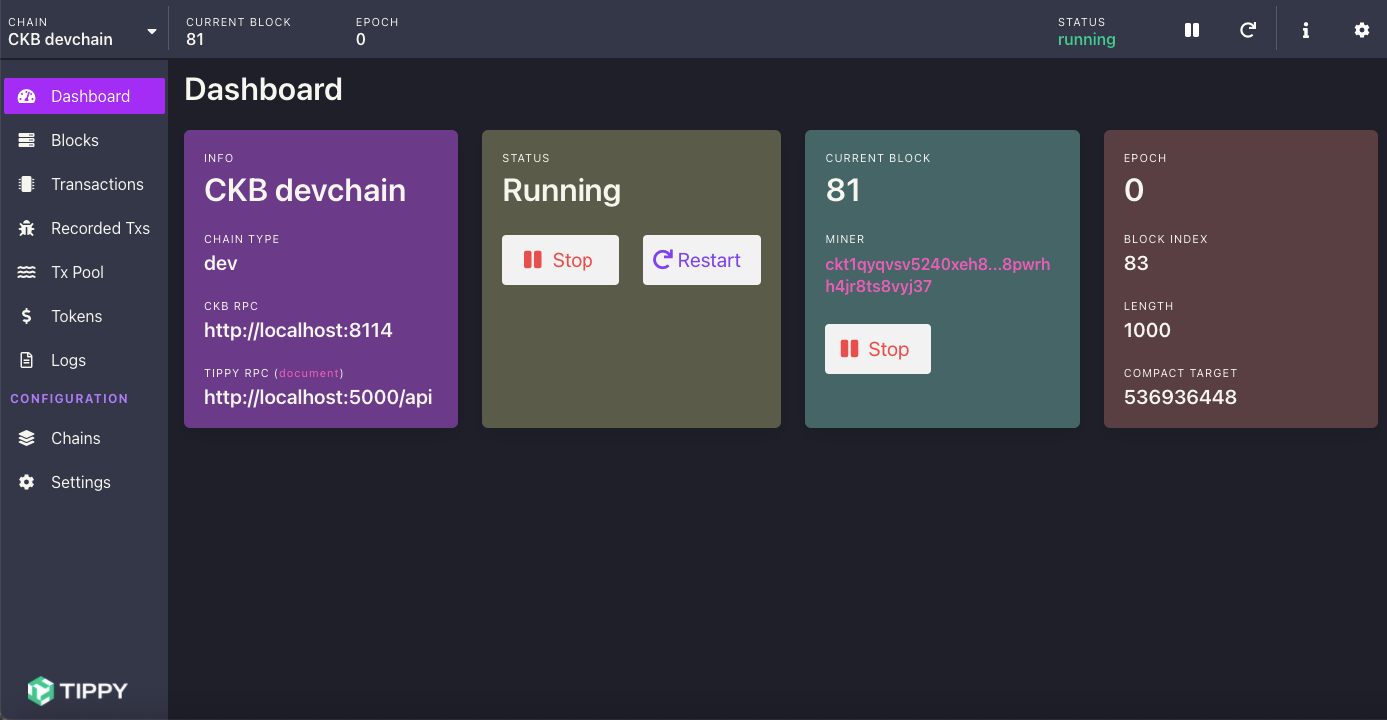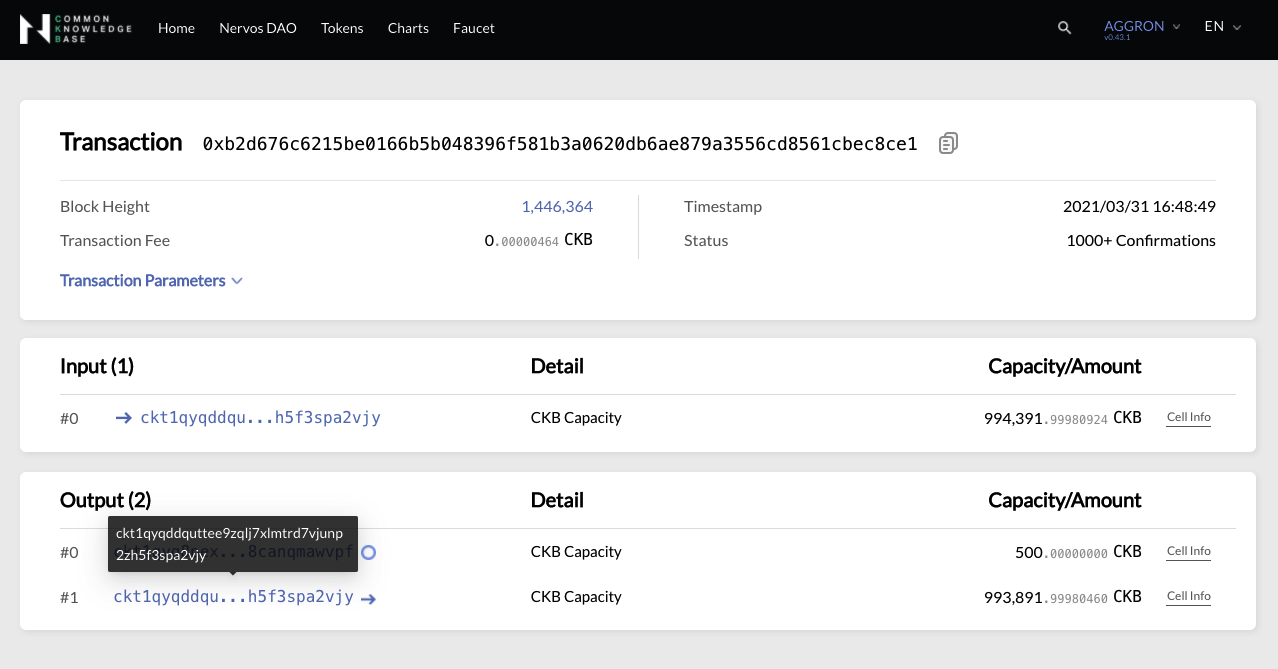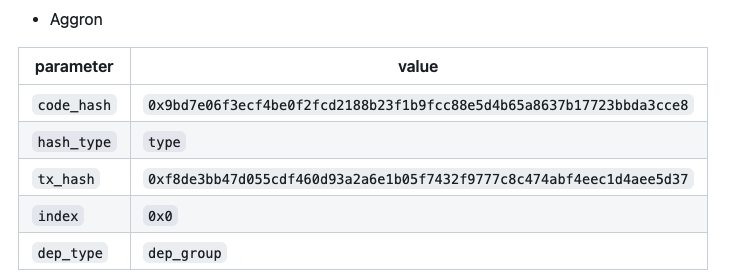RPC and Transaction
What's the difference between DApps and web apps?#
I'm sure you already have the skills to develop web apps (probably more than I do). To help you understand DApps, let's take a look at the differences between DApps and web apps.
note
The DApps mentioned in this document site are all DApps running on CKB layer1. Due to the uniqueness of Nervos CKB network, DApps are developed in a very different way than DApps on other blockchains, especially Ethereum, so please empty your cup first.
APP
- Client
- Send requests through HTTP
- Back-end: write programs that respond to requests.
- Web server, such as nginx/apache
DApp
- Client
- Send requests through RPC
- Back-end: send transactions that respond to requests.
- CKB network
The client side of web apps and DApps are almost the same, you should focus on the implementation of back-end and RPC, so let's look through RPC and transaction first.
RPC#
Nervos CKB exposes a set of RPCs in JSON-RPC 2.0 protocols for interactions,see JSON-RPC.
First run a CKB node,then use RPC in @ckb-lumos/rpc (the RPC component in Lumos) to interact with CKB network,communicating block and transaction information with CKB nodes.
info
Lumos is a very handy development tool. CKB DApps can be developed upon lumos. A transfer-tx DApp demo will introduce how to develop DApps upon lumos step by step.
Set Up the Development Environment#
See Set Up the Development Environment,then you will run a CKB node on Dev Chain by using Tippy.
An example of Tippy's dashboard
 Figure 1 an example of Tippy's dashboard
Figure 1 an example of Tippy's dashboard
Connect to CKB node through RPC#
$ yarn add @ckb-lumos/rpcGet the blockchain info
const { RPC } = require("@ckb-lumos/rpc");const rpc = new RPC("http://localhost:8114");async function main(){ const result = await rpc.get_blockchain_info(); console.log(result);}main();An example of the blockchain info:
alerts: [], chain: "ckb_dev", difficulty: "0x100", epoch: "0x64005b0000bc", is_initial_block_download: false, median_time: "0x17b9c952a1d"The full code of the example can be found here.
Great! Now you have got your foot in the door!
A transfer transaction on CKB Testnet#
At its core, a blockchain is a replicated deterministic state machine.A state machine is a computer science concept whereby a machine can have multiple states, but only one at any given time. There is a state, which describes the current state of the system, and transactions, that trigger state transitions.Given a state S and a transaction T, the state machine will return a new state S'.
+--------+ | | | S | | | +--------+ | | T |+--------+ | | | S' | | | +--------+ Nervos CKB Layer1 also follows this logic, the following is a transfer transaction on CKB Aggron Testnet:
- The payer's address:ckt1qyqddquttee9zqlj7xlmtrd7vjunp2zh5f3spa2vjy
- The recipient's address:ckt1qyqv70xf5cusptp0gwzqj8ewsen7j2c0aa8sq5d7y6
An example of a transfer transaction on CKB Aggron Testnet
{ "version": "0x0", "cell_deps": [ { "out_point": { "tx_hash": "0xf8de3bb47d055cdf460d93a2a6e1b05f7432f9777c8c474abf4eec1d4aee5d37", "index": "0x0" }, "dep_type": "dep_group" } ], "header_deps": [], "inputs": [ { "since": "0x0", "previous_output": { "tx_hash": "0xb2d676c6215be0166b5b048396f581b3a0620db6ae879a3556cd8561cbec8ce1", "index": "0x1" } } ], "outputs": [ { "capacity": "0x56cc9c900", "lock": { "code_hash": "0x9bd7e06f3ecf4be0f2fcd2188b23f1b9fcc88e5d4b65a8637b17723bbda3cce8", "hash_type": "type", "args": "0xcf3cc9a63900ac2f4384091f2e8667e92b0fef4f" } }, { "capacity": "0x5a5f6d2bccdc", "lock": { "code_hash": "0x9bd7e06f3ecf4be0f2fcd2188b23f1b9fcc88e5d4b65a8637b17723bbda3cce8", "hash_type": "type", "args": "0xd6838b5e725103f2f1bfb58dbe64b930a857a263" } } ], "outputs_data": [ "0x", "0x" ], "witnesses": [ "0x550000001000000055000000550000004100000078aa17dc603d72b8dcd7d214f9a6e4bb4bbf6c77f172a66d889f3958aa16f8a812e6b7d3e3ed56f361d255b7a834bdbc2e69442da536e2ae7a0b3feffa2b556f01" ]}The transaction JSON code looks a bit complicated, don't panic, let's look through Inputs and Outputs first.
Inputs and Outputs#
"inputs": [ { "since": "0x0", "previous_output": { "tx_hash": "0xb2d676c6215be0166b5b048396f581b3a0620db6ae879a3556cd8561cbec8ce1", "index": "0x1" } } ], "outputs": [ { "capacity": "0x56cc9c900", "lock": { "code_hash": "0x9bd7e06f3ecf4be0f2fcd2188b23f1b9fcc88e5d4b65a8637b17723bbda3cce8", "hash_type": "type", "args": "0xcf3cc9a63900ac2f4384091f2e8667e92b0fef4f" } }, { "capacity": "0x5a5f6d2bccdc", "lock": { "code_hash": "0x9bd7e06f3ecf4be0f2fcd2188b23f1b9fcc88e5d4b65a8637b17723bbda3cce8", "hash_type": "type", "args": "0xd6838b5e725103f2f1bfb58dbe64b930a857a263" } } ], "outputs_data": [ "0x", "0x" ],You may find that there are two objects in the outputs that are similar in structure (put aside the inputs now).
You got it! This is called Cell which is the best design in Nervos CKB!
Cell#
Cells are the primary state units in CKB, so the state transition can be represented as follows:
+--------+ | | | Cells | | | +--------+ | | transfer transaction |+--------+ | | | Cells' | | | +--------+
A cell has the following fields:
Cell: { //field name: type capacity: Uint64 lock: Script type: Script data: Bytes } - capacity:Size limit of the cell, also the number of native tokens owned by the cell.
- lock:If you think of a cell as a box,it's a lock of the box. Every cell has a lock script.
- type: Another type of lock with different uses,it's optional.
- data: State data stored in this cell, could be any format.
outputs_data: The actual data are kept separated for the ease of CKB script handling and for the possibility of future optimizations.
Then look through the inputs,you will find a field called "previous_output" in inputs
"inputs": [ { "since": "0x0", "previous_output": { "tx_hash": "0xb2d676c6215be0166b5b048396f581b3a0620db6ae879a3556cd8561cbec8ce1", "index": "0x1" } } ],The field's name have been fully expressed: inputs is the previous_output. The inputs can be indexed through tx_hash and index.If you open CKB-Explorer (switch to AGGRON) ,search for tx_hash, you will find the inputs with the similar address of the payer's address.
An example usage of CKB-Explorer
 Figure 2 an example usage of CKB-Explorer
Figure 2 an example usage of CKB-Explorer
In conclusion, the essence of the transaction is to spend some cells, and then generate some new cells, which will also become input cells that need to be spent in another transaction. The unspent cells are called live cells. This concepts are similar to that of UTXO in Bitcoin's terminology.
the state transition can be represented as follows:
+--------+ | | | Cell A | | | +--------+ | | transfer transaction |+--------+ | | | Cell B || Cell C || | +--------+
cell_deps and Witnesses#
Have you found out? out_point also made up of tx_hash and index in cell_deps, so cell_deps is actually pointed to a cell indexed by tx_hash and index, so what is this cell for?
"cell_deps": [ { "out_point": { "tx_hash": "0xf8de3bb47d055cdf460d93a2a6e1b05f7432f9777c8c474abf4eec1d4aee5d37", "index": "0x0" }, "dep_type": "dep_group" } ],SECP256K1_BLAKE160 is a piece of code using the same secp256k1 signature verification algorithm as used in bitcoin.It is the default lock script used to protect the ownership of each cell.
There is one cell created in the genesis block and SECP256K1_BLAKE160 code is compiled and put in the data field of the cell. The transfer transaction should use it as cell_deps to protect the ownership of inputs and outputs.
The tx_hash and index are the same with SECP256K1_BLAKE160 info.

Figure 3 the info of secp256k1 cell in Aggron Testnet.
Lock Script#
So what is the specific mode of operation?
The type of the lock script is Script, A cell has the following fields:
Script: {// field name: type code_hash: H256(hash) args: Bytes hash_type: String, could be `type` or `data` } The hash_type means that the interpretation of code hash when looking for matched dep cells. The default lock script should be type.The code_hash is dep_cell's code hash, and the args is the payer's public key hash. When the payer commits a transaction, TA should sign the transaction with private key, which is what Witnesses puts it on.:
The default lock script: { code_hash: SECP256K1 code hash args: the payer's public key hash hash_type: `type` } In this way,the SECP256K1 encryption algorithm with the public key and signature can figure out whether the transaction was committed by the corresponding private key, and also figure out whether the real owner is operating behind it.
The code_hash in the lock script are the same with code_hash in SECP256K1_BLAKE160 info.

Figure 4 the code hash of secp256k1 cell in Aggron Testnet.
"cell_deps": [ { "out_point": { "tx_hash": "0xf8de3bb47d055cdf460d93a2a6e1b05f7432f9777c8c474abf4eec1d4aee5d37", "index": "0x0" }, "dep_type": "dep_group" } ], ...... "outputs": [ { "capacity": "0x56cc9c900", "lock": { "code_hash": "0x9bd7e06f3ecf4be0f2fcd2188b23f1b9fcc88e5d4b65a8637b17723bbda3cce8", "hash_type": "type", "args": "0xcf3cc9a63900ac2f4384091f2e8667e92b0fef4f" } }, { "capacity": "0x5a5f6d2bccdc", "lock": { "code_hash": "0x9bd7e06f3ecf4be0f2fcd2188b23f1b9fcc88e5d4b65a8637b17723bbda3cce8", "hash_type": "type", "args": "0xd6838b5e725103f2f1bfb58dbe64b930a857a263" } } ], "outputs_data": [ "0x", "0x" ], "witnesses": [ "0x550000001000000055000000550000004100000078aa17dc603d72b8dcd7d214f9a6e4bb4bbf6c77f172a66d889f3958aa16f8a812e6b7d3e3ed56f361d255b7a834bdbc2e69442da536e2ae7a0b3feffa2b556f01" ]}Address and Lock Script#
The last thing you need to understand is Address on CKB network.
On CKB network,an accont is a set of live cells with similar lock script. An address is packaged the lock script into a single line with verificable and human readable format. The prefix of "ckt" is means that the address is generated on CKB testnet, see RFC: CKB Address Format
Therefore, an address is represented as an account. The relationship between private key, public key(args), lock script, and CKB address is represented here.
Create CKB accounts#
You can use CKB-CLI to generate accounts
- Prerequisites:Run a CKB Node on DEV Chain by Using Tippy
- Step 1. Download the CKB pre-built installer package.
- Step 2. Verify the ckb-cli tool is working and check the version.
- Step 3. Create the account
- Step 4. Get the private key for the account
- Step 5. Get CKB capacity for the account
This is the payer's account info:
address: mainnet: ckb1qyqddquttee9zqlj7xlmtrd7vjunp2zh5f3suc5n7c testnet: ckt1qyqddquttee9zqlj7xlmtrd7vjunp2zh5f3spa2vjylock_arg: 0xd6838b5e725103f2f1bfb58dbe64b930a857a263lock_hash: 0x10f9a227094e77ee9149b3e8ed1e34f6d5c7c604bab81e0df42f13e1d33ac0fb This is the recipient's account info:
address: mainnet: ckb1qyqv70xf5cusptp0gwzqj8ewsen7j2c0aa8sa3npgx testnet: ckt1qyqv70xf5cusptp0gwzqj8ewsen7j2c0aa8sq5d7y6 lock_arg: 0xcf3cc9a63900ac2f4384091f2e8667e92b0fef4f lock_hash: 0xc7cea924f48d069396b6826ee17653580d90d505544fa6940dbba3d24d9258baThe lock_arg in the address is similar with the args in the outputs.
"outputs": [ { "capacity": "0x56cc9c900", "lock": { "code_hash": "0x9bd7e06f3ecf4be0f2fcd2188b23f1b9fcc88e5d4b65a8637b17723bbda3cce8", "hash_type": "type", "args": "0xcf3cc9a63900ac2f4384091f2e8667e92b0fef4f" } }, { "capacity": "0x5a5f6d2bccdc", "lock": { "code_hash": "0x9bd7e06f3ecf4be0f2fcd2188b23f1b9fcc88e5d4b65a8637b17723bbda3cce8", "hash_type": "type", "args": "0xd6838b5e725103f2f1bfb58dbe64b930a857a263" } } ], "outputs_data": [ "0x", "0x" ], "witnesses": [ "0x550000001000000055000000550000004100000078aa17dc603d72b8dcd7d214f9a6e4bb4bbf6c77f172a66d889f3958aa16f8a812e6b7d3e3ed56f361d255b7a834bdbc2e69442da536e2ae7a0b3feffa2b556f01" ]}Witnesses#
In the transfer transaction case, the Witnesses just include signature which is generated by the payer's private key.
tip
if lock script is 0
Witnesses = List(["0x55000000100000005500000055000000410000000000000000000000000000000000000000000000000000000000000000000000000000000000000000000000000000000000000000000000000000000000000000"]);Summary#
The transfer transaction can be represented as follows:
cell_deps: * point to the cell with SECP256K1 code
inputs: * The payer's cell:point to previous_output
outputs: * the recipient's cell * capacity: 0x56cc9c900 * lock script * SECP256K1 code hash * the recipient's public_key hash * data: 0x * the payer's cell * capacity: 0x5a5f6d2bccdc * lock script * SECP256K1 code hash * the payer's public_key hash * data: 0x
witnesses: * include the payer's signatureSign the transfer transaction#
It is required the following arguments to sign the transfer transaction,this is the default signing solution used in CKB now. For more information,see How to sign transaction
* public key, secp256k1 private key* witnesses which include the signatureThe other fields of version , header_deps,since are not covered by this document site , see RFC: Data Structures of Nervos CKB